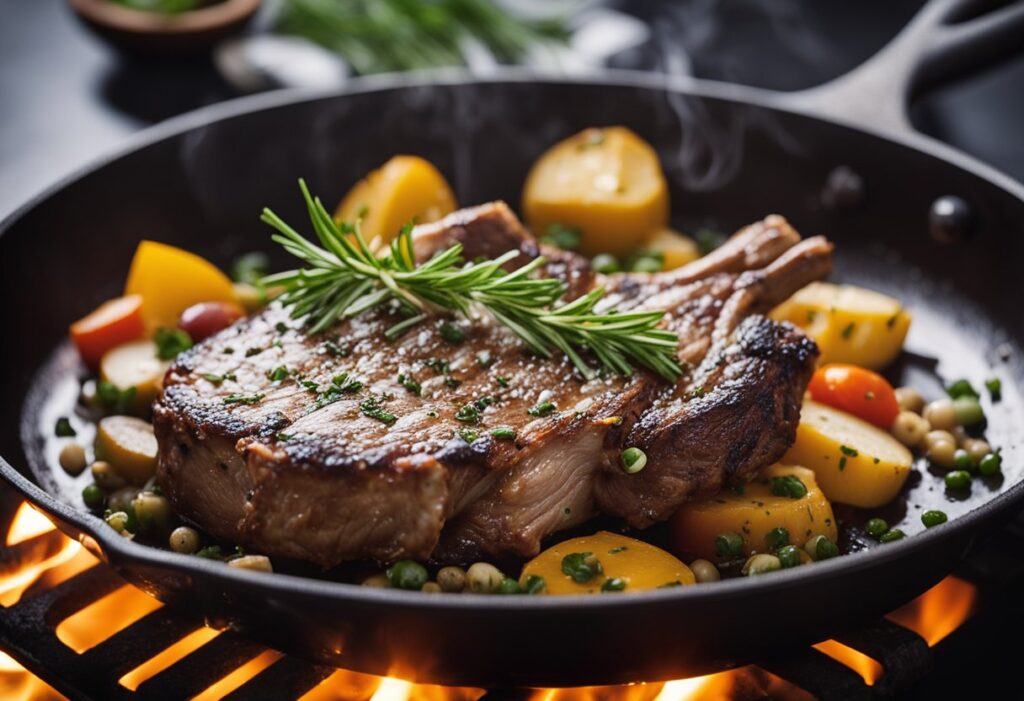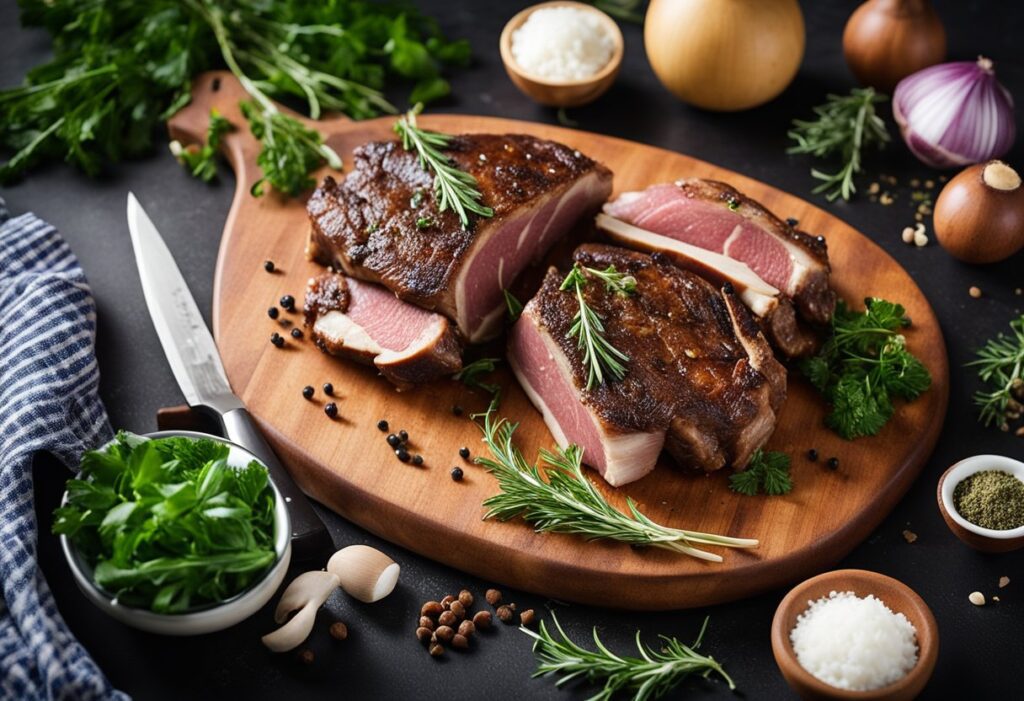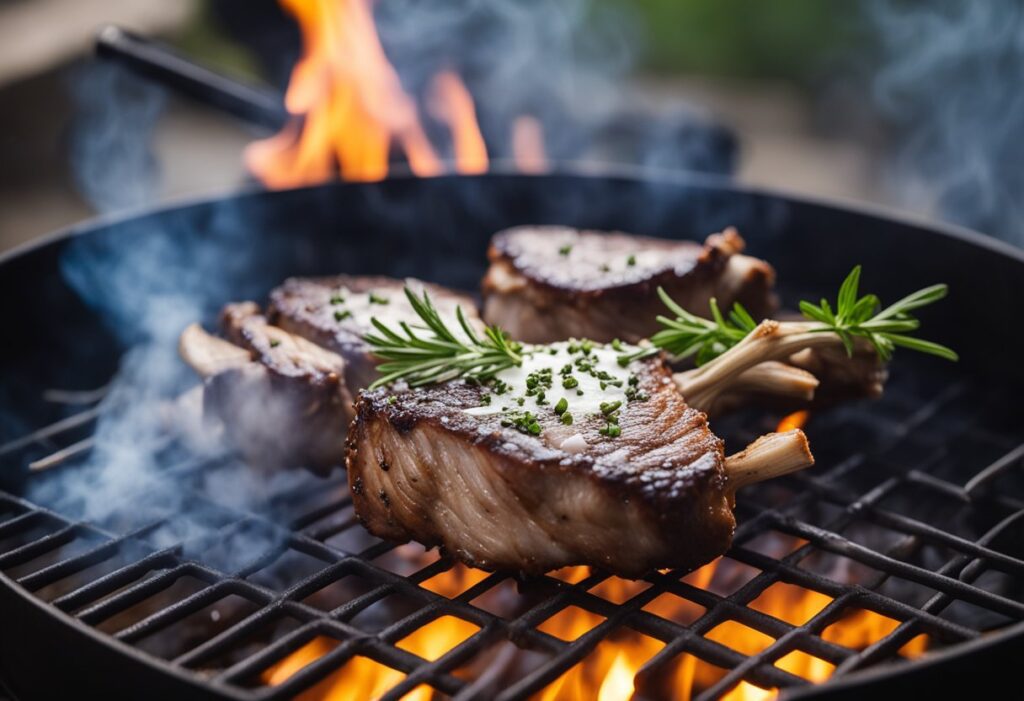Lamb shoulder chops are a delicious and flavorful cut of meat that can be prepared in numerous ways. Whether grilled, roasted, or pan-seared, lamb shoulder chops are a versatile ingredient that can be dressed up or down depending on the occasion. In this article, we will explore the different ways to cook lamb shoulder chops and provide tips for achieving the perfect dish.

Firstly, it’s important to choose the right cut of lamb shoulder chop. Look for chops that are evenly sized and have a good amount of marbling, as this will ensure a tender and juicy result. Lamb shoulder chops can be bone-in or boneless, and both options work well for different cooking methods.
Grilling is a popular method for cooking lamb shoulder chops, as it imparts a smoky flavor and crispy exterior. However, roasting and pan-searing are also great options, as they allow for more control over the cooking process and can result in a more tender and juicy end product. With the right techniques and seasoning, cooking lamb shoulder chops can be a simple and delicious way to elevate any meal.
Selecting Lamb Shoulder Chops
Understanding Lamb Grades
Before selecting lamb shoulder chops, it’s important to understand the grading system for lamb. The United States Department of Agriculture (USDA) grades lamb based on its age, meat color, and fat content. The grades range from prime to utility, with prime being the highest quality.
Prime lamb is typically found in high-end restaurants and specialty meat markets and has a bright red color, fine marbling, and a tender texture. Choice lamb is the most commonly sold grade in supermarkets and has a slightly darker color, moderate marbling, and a good flavor. Select lamb has the least amount of marbling and is leaner than the other grades, making it a good choice for those who are watching their fat intake. Utility lamb is the lowest grade and is usually used for processed meat products.
Choosing the Right Cut
When selecting lamb shoulder chops, look for cuts that are bright red in color and have a good amount of marbling. The marbling is important because it adds flavor and helps keep the meat moist during cooking. Lamb shoulder chops come in several different cuts, including blade, arm, and shoulder.
Blade chops are the most common and have a small round bone in the center. They are a good choice for grilling or broiling. Arm chops are cut from the upper portion of the shoulder and have a small bone in the center. They are a good choice for braising or stewing. Shoulder chops are cut from the lower portion of the shoulder and have a larger bone in the center. They are a good choice for slow cooking methods like roasting or braising.
When selecting lamb shoulder chops, it’s important to choose the right cut for your cooking method. Blade chops are best suited for grilling or broiling, while arm and shoulder chops are better for braising or stewing. By understanding the grading system and choosing the right cut, you can ensure that your lamb shoulder chops will turn out moist, flavorful, and delicious.
Preparation Basics

Trimming Excess Fat
Before cooking lamb shoulder chops, it is important to trim any excess fat off the meat. This not only improves the overall texture of the dish, but also reduces the amount of grease and oil that can accumulate in the pan while cooking. A sharp knife is recommended to make precise cuts and remove the fat without damaging the meat.
Marinating for Flavor
Marinating lamb shoulder chops is a great way to add flavor and tenderness to the meat. A simple marinade can be made by combining olive oil, garlic, lemon juice, and herbs such as rosemary or thyme. The lamb should be placed in the marinade and left in the refrigerator for at least 2 hours to allow the flavors to penetrate the meat.
Bringing to Room Temperature
It is important to bring lamb shoulder chops to room temperature before cooking. This allows the meat to cook more evenly and prevents it from becoming tough. Simply take the lamb out of the refrigerator 30 minutes before cooking and allow it to sit at room temperature. This step is especially important if you plan to grill the lamb, as cold meat can cause the grill temperature to drop and result in uneven cooking.
Cooking Methods

Grilling Lamb Shoulder Chops
Grilling is a popular method for cooking lamb shoulder chops. It’s a quick and easy way to cook the meat while adding a smoky flavor. Before grilling, season the chops with salt, pepper, and any other desired seasonings. Preheat the grill to medium-high heat and place the chops on the grill. Cook for 3-4 minutes per side, or until the internal temperature reaches 145°F for medium-rare. Let the chops rest for a few minutes before serving.
Pan-Searing
Pan-searing is another great way to cook lamb shoulder chops. Heat a skillet over medium-high heat and add a small amount of oil. Season the chops with salt and pepper, then add them to the skillet. Cook for 3-4 minutes per side, or until the internal temperature reaches 145°F for medium-rare. Let the chops rest for a few minutes before serving.
Oven-Roasting
Oven-roasting is a slower method of cooking lamb shoulder chops, but it results in tender and juicy meat. Preheat the oven to 375°F. Season the chops with salt, pepper, and any other desired seasonings. Place the chops in a baking dish and roast for 25-30 minutes, or until the internal temperature reaches 145°F for medium-rare. Let the chops rest for a few minutes before serving.
Slow-Cooking
Slow-cooking is a great option for busy cooks who want to come home to a delicious meal. Season the lamb shoulder chops with salt, pepper, and any desired seasonings. Place the chops in a slow cooker and add any desired vegetables or liquids. Cook on low for 6-8 hours, or until the meat is tender and falls off the bone. Serve with the cooking liquid and vegetables, if desired.
Cooking Times and Temperatures
Rare to Well-Done Guidelines
Cooking lamb shoulder chops to the desired level of doneness is crucial to achieve the best possible flavor and texture. Here are some guidelines to follow:
- Rare: Cook the lamb shoulder chops for 2-3 minutes per side over high heat. The internal temperature should be around 120°F (49°C).
- Medium-rare: Cook the lamb shoulder chops for 3-4 minutes per side over medium-high heat. The internal temperature should be around 130°F (54°C).
- Medium: Cook the lamb shoulder chops for 4-5 minutes per side over medium heat. The internal temperature should be around 140°F (60°C).
- Medium-well: Cook the lamb shoulder chops for 5-6 minutes per side over medium-low heat. The internal temperature should be around 150°F (65°C).
- Well-done: Cook the lamb shoulder chops for 6-7 minutes per side over low heat. The internal temperature should be around 160°F (71°C).
Using a Meat Thermometer
Using a meat thermometer is the most accurate way to determine the doneness of lamb shoulder chops. Insert the thermometer into the thickest part of the chop, making sure it does not touch the bone. Here are the recommended internal temperatures for different levels of doneness:
- Rare: 120-125°F (49-52°C)
- Medium-rare: 130-135°F (54-57°C)
- Medium: 140-145°F (60-63°C)
- Medium-well: 150-155°F (65-68°C)
- Well-done: 160°F (71°C) or higher
By following these guidelines and using a meat thermometer, you can ensure that your lamb shoulder chops are cooked to perfection every time.
Serving and Presentation
Resting Before Serving
Before serving the lamb shoulder chops, it is important to let them rest for a few minutes. This resting period allows the juices to redistribute throughout the meat, resulting in a more tender and flavorful dish. It is recommended to let the lamb shoulder chops rest for at least 5-10 minutes before serving.
Accompaniments and Side Dishes
Lamb shoulder chops pair well with a variety of side dishes and accompaniments. Roasted vegetables such as carrots, potatoes, and Brussels sprouts make for a delicious and hearty side dish. For a lighter option, a fresh salad with a tangy vinaigrette can complement the rich flavors of the lamb. Other popular accompaniments include rice pilaf, couscous, or roasted sweet potatoes.
Garnishing for Aesthetics
Garnishing the lamb shoulder chops can add an extra touch of elegance to the dish. Fresh herbs such as rosemary or thyme can be used to add both flavor and visual appeal. A sprinkle of chopped parsley or cilantro can also add a pop of color to the plate. For a more decadent presentation, a drizzle of balsamic reduction or a dollop of mint sauce can elevate the dish to the next level.
Remember to arrange the side dishes and garnishes in an aesthetically pleasing manner on the plate. This will not only make the dish look more appetizing, but will also enhance the overall dining experience.
Food Safety and Storage
Proper Handling
When handling lamb shoulder chops, it is important to follow proper food safety guidelines to prevent the growth of harmful bacteria. Always wash your hands with soap and warm water before and after handling raw meat. Additionally, use separate cutting boards and utensils for raw meat to avoid cross-contamination.
Refrigeration and Freezing
To maximize the shelf life of lamb shoulder chops, they should be stored in the refrigerator or freezer. If you plan to use the chops within a few days, store them in the refrigerator at a temperature below 40°F. If you won’t be using them within a few days, freeze them at 0°F or below. When storing in the freezer, it is recommended to wrap the chops tightly in plastic wrap or aluminum foil to prevent freezer burn.
Reheating Leftovers
When reheating leftover lamb shoulder chops, it is important to ensure they reach a temperature of at least 165°F to kill any bacteria that may have grown during storage. To reheat, place the chops in a microwave-safe dish and cover with a damp paper towel. Microwave on high in 30-second intervals until the desired temperature is reached. Alternatively, the chops can be reheated in the oven at 350°F for 10-15 minutes or until heated through. Avoid reheating the same portion of meat more than once to reduce the risk of foodborne illness.

